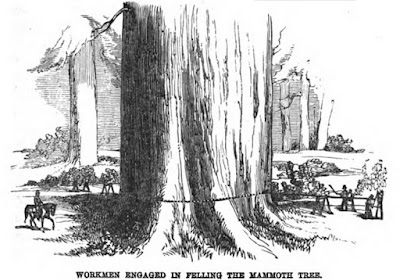 |
| The Giant (a.k.a. Fremont's Tree) by Dave Kuty |
The Giant is certainly the monarch of Big Trees Grove. Due to its overall size, the Giant remains the grove’s largest redwood. In the 19th century the Giant towered above all its neighbors, with estimates of its height varying between 306 to 381 feet.* We are fortunate not only that Joseph Warren Welch first protected this forest monarch when he purchased the grove in 1867, but also for the failure of a scheme which earlier threatened the Giant’s very survival.
The threat to the Giant came in 1853. Ironically, that initial threat originated with the discovery of the giant sequoia in the Sierra Nevada the year before. The story goes that the giant sequoia were “discovered” by Augustus T. Dowd in Calaveras county while he was hunting for meat to feed crews working on a water project for the town of Murphys.**
One of the men who first accompanied Dowd to the site of his discovery was a gentleman named Lewis who had a money-making scheme. Lewis proposed that the bark of the largest tree in the Calaveras Grove, the Mammoth Tree (since known as the Discovery Tree), should be stripped, and reassembled as an exhibit for profit.
 |
|
Mammoth Trees of California compiled by J. Otis Williams, 1871. |
 |
|
“Mammoth Tree,” Gleason’s Pictorial Drawing-Room Companion, Volume VI, No. 10, March 11, 1854. |
Before Hanford’s financial failure became apparent, Lewis continued to pursue his original plan. Now seeking to find a giant tree to rival his competitor and still upset at the "underhanded proceeding" he suffered, Lewis traveled to Santa Cruz to visit the large coast redwood originally described by John Charles Frémont in 1846. Upon arrival Lewis soon realized that Fremont’s Tree would not satisfy his plans for "… although large, only nineteen feet in diameter and 286 feet in height, while that in Calaveras county was thirty feet in diameter and 302 feet in height, he then turned his steps [elsewhere] … consequently, much discouraged, and after spending about five hundred dollars and several weeks’ time, he eventually abandoned his undertaking."
Thankfully, our beloved Giant was not large enough for Lewis’ scheme and we still have it here to enjoy today.
* Sometime in the 19th century a windstorm reportedly broke off the Giant’s top, removing anywhere from an estimated 25 to 75 feet. Today the Giant measures just over 275 feet.
** Of course, the Native people of the Sierra Nevada knew of the giant sequoia for many centuries. During the 1840s and early 1850s there were several American pioneers who also claimed to have “discovered” the giant sequoias. As it turned out, most of these reports were ignored until the one provided by Dowd.
Sources: “Santa Cruz Big Trees,” Santa Cruz Evening Sentinel, April 1, 1902; Scenes of Wonder and Curiosity in California, by J.M. Hutchings, A. Roman and Company, Publishers, New York, 1875; King Sequoia – The Tree That Inspired a Nation, Created Our National Park System, and Changed the Way We Think About Nature, by William C. Tweed, Heyday and Sierra College Press, Berkeley, 2016; “How a Giant Tree’s Death Sparked the Conservation Movement 160 Years Ago,” by Leo Hickman, The Guardian, June 27, 2013, https://www.theguardian.com/environment/blog/2013/jun/27/giant-tree-death-conservation-movement.
